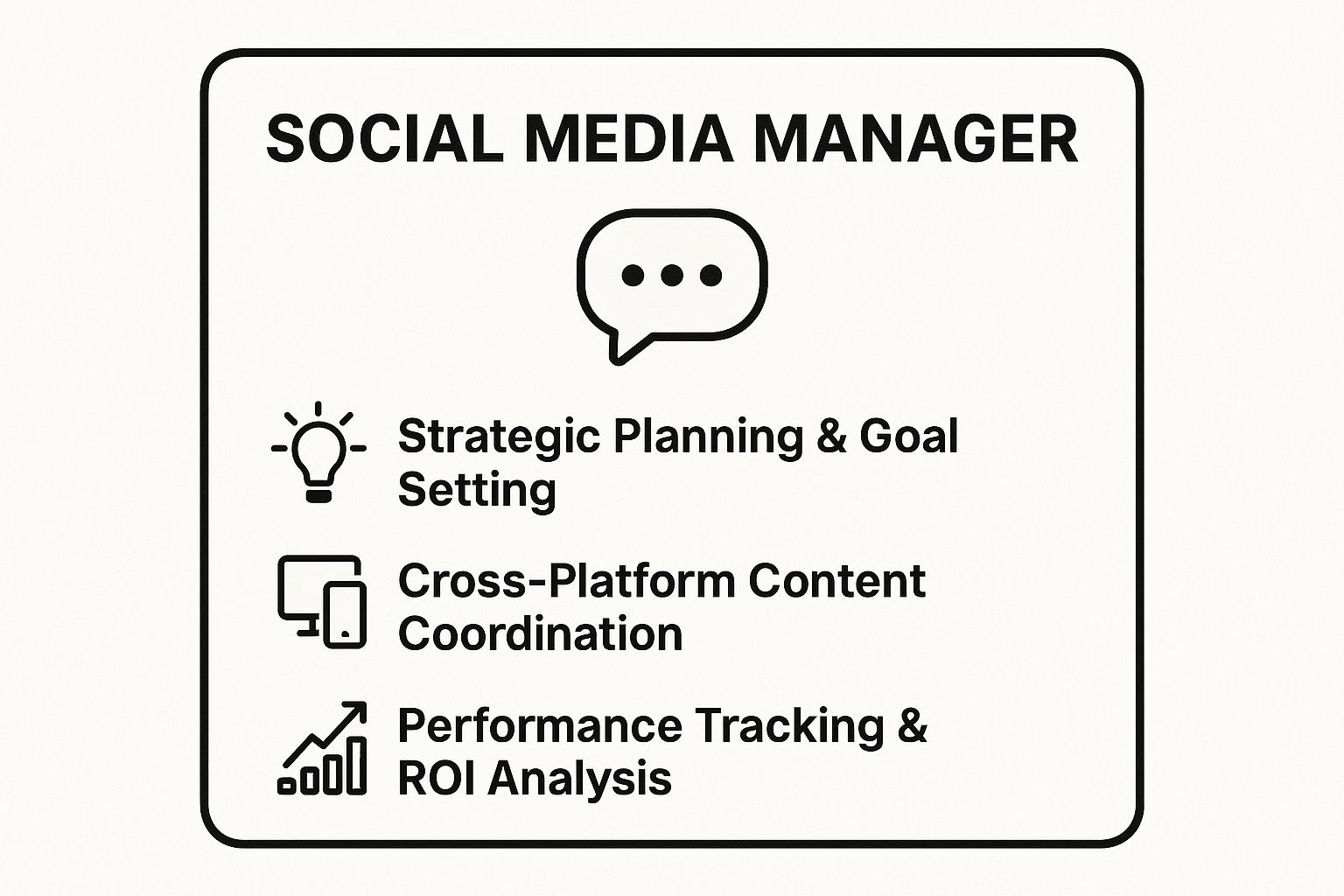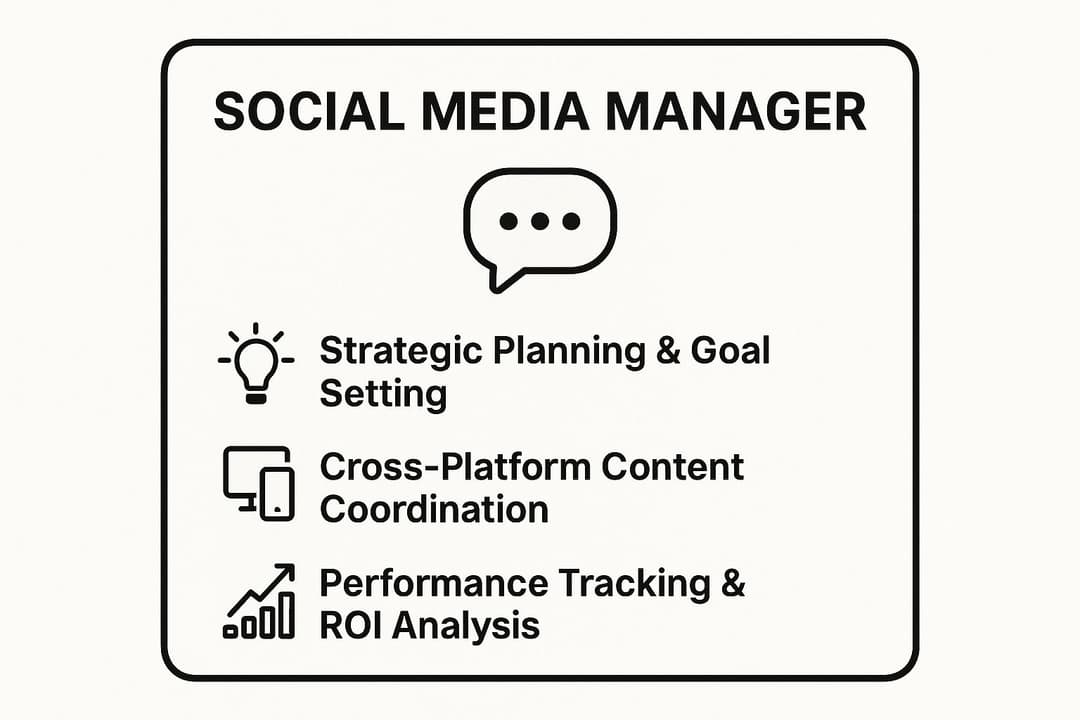In 2025, relying on a single 'social media person' to manage your entire online presence is like asking one person to be the CEO, accountant, and marketer for a whole company. It’s no longer a sustainable strategy for growth. To genuinely succeed, you need a specialized team where each member plays a distinct, vital part. A well-structured team transforms your social media from a daily chore into a powerful engine for brand growth, customer loyalty, and revenue.
This guide is your blueprint for assembling that high-performance unit. We will break down the seven essential social media team roles, outlining exactly what each position entails, the skills required to excel, and how they collaborate to create a cohesive and effective strategy. Moving beyond a one-person-show is the most critical step to scaling your efforts.
You will learn to identify the specific responsibilities of a strategist versus a content creator, and an analyst versus a community manager. Understanding these distinctions is fundamental to building an efficient workflow, assigning clear ownership, and ultimately, achieving measurable business results. Let's dive into the core positions that will make up your social media dream team.
1. Social Media Manager
The Social Media Manager is the strategic hub of your social media operations. More than just a content scheduler, this role is the architect of your brand's entire online presence. They are responsible for developing a comprehensive strategy that aligns with core business goals, ensuring every tweet, post, and story serves a greater purpose. This leader coordinates all moving parts, from content creation to community engagement and performance analysis, making it one of the most critical social media team roles.
A Social Media Manager’s primary function is to translate business objectives into a tangible social media action plan. This involves deep audience research, platform selection, and creating a cohesive content calendar that tells a consistent brand story. Think of Wendy's famously witty and responsive Twitter presence or Nike’s powerful, integrated campaigns across multiple platforms; these are the results of a strong managerial vision.
Core Responsibilities and Impact
This role is responsible for the big-picture view and the day-to-day execution that brings it to life. For a deeper dive into the specific advantages, explore the benefits of hiring a Social Media Manager. Their tasks often include setting KPIs, managing budgets, and reporting on ROI to leadership.
Here is a quick reference summarizing the core pillars of the Social Media Manager's responsibilities.

As the visual highlights, this role balances high-level strategy with practical oversight and data-driven analysis to ensure the team’s efforts generate measurable business value.
Key Skills and Tools
To succeed, a Social Media Manager needs a hybrid skill set combining creativity with analytical prowess.
- Strategic Planning: The ability to develop long-term social media strategies that support marketing and sales funnels.
- Leadership: Guiding content creators, community managers, and analysts toward a unified goal.
- Analytical Skills: Using data to measure campaign success, track KPIs, and make informed decisions for future content.
- Project Management: Proficiency with tools like Asana, Trello, and Sprout Social is essential for managing complex content calendars and team workflows.
2. Content Creator/Social Media Specialist
If the Social Media Manager is the architect, the Content Creator/Social media Specialist is the master craftsperson. This role is the creative engine of the social media team, responsible for producing the tangible assets that audiences see, engage with, and share. They transform strategic goals into compelling posts, stories, videos, and graphics that capture attention and communicate the brand's personality. This is one of the most hands-on social media team roles, demanding a blend of artistic vision and platform-specific expertise.

A Content Creator's primary function is to bring the brand's voice and aesthetic to life. They are responsible for the day-to-day execution of the content calendar, ensuring everything published is high-quality, on-brand, and optimized for its intended platform. Think of Chipotle's TikTok-native videos that feel authentic to the platform or National Geographic's breathtaking photography on Instagram; these are the direct results of a skilled creator who understands both their brand and the digital landscape.
Core Responsibilities and Impact
This role directly influences how the audience perceives and interacts with the brand. To boost efficiency and innovation, a Content Creator/Social Media Specialist can leverage new technologies, including exploring the best AI content creation tools. Their duties range from brainstorming ideas and copywriting to shooting videos and designing graphics.
Successful content creation is not just about making things look good; it's about driving engagement and action. By mastering the nuances of visual storytelling and platform algorithms, a specialist ensures the brand's message cuts through the noise. For a deeper understanding of the principles they follow, review these content marketing best practices that guide effective creation.
Key Skills and Tools
A successful Content Creator/Social Media Specialist needs a dynamic combination of creative talent and technical know-how.
- Multimedia Production: Proficiency in creating visuals, videos, and copy. This includes skills in graphic design, video editing, and compelling storytelling.
- Platform Expertise: Deep understanding of the content formats and user behaviors specific to each social platform, like Instagram Reels, TikTok trends, or LinkedIn articles.
- Creativity and Adaptability: The ability to generate fresh ideas consistently and adapt the brand's voice to different contexts and trends.
- Content Creation Tools: Expertise with software like Adobe Creative Suite (Photoshop, Premiere Pro), Canva, Figma, and mobile video editing apps is crucial for producing professional-grade content.
3. Community Manager
The Community Manager is the heart and soul of your brand's online presence, serving as the direct link between the company and its audience. While other social media team roles focus on content creation and strategy, this individual is dedicated to building, nurturing, and protecting the community. They are the human voice behind the logo, responsible for fostering authentic relationships, managing conversations, and turning passive followers into loyal brand advocates.
A Community Manager’s primary function is to listen, engage, and facilitate meaningful dialogue. This role moves beyond simple content posting to actively participate in conversations, respond to comments and messages, and monitor brand mentions across the web. Think of Sephora’s Beauty Insider Community, which thrives on user-generated content and peer-to-peer advice, or Xbox’s vibrant gaming forums; these are cultivated by dedicated community management that makes customers feel heard and valued.
Core Responsibilities and Impact
This role is responsible for maintaining brand reputation and fostering a positive environment where customers feel connected. For a deeper look into creating these spaces, learn more about how to build online communities effectively. Their tasks often include moderating discussions, responding to customer service inquiries, identifying brand advocates, and providing audience feedback to internal teams like marketing and product development.
This role transforms a social media page from a broadcast channel into a two-way conversation, which is essential for building long-term loyalty and trust.
Key Skills and Tools
A successful Community Manager needs a unique blend of empathy, communication skills, and strategic thinking.
- Empathy and Customer Service: The ability to understand customer concerns and respond with a helpful, patient, and brand-aligned tone, even in difficult situations.
- Communication Skills: Excellent written and verbal communication to clearly and effectively interact with community members.
- Proactive Engagement: Using social listening tools like Brand24 or Mention to find and join relevant conversations happening outside the brand’s own channels.
- Conflict Resolution: The skill to de-escalate negative conversations and turn frustrated customers into satisfied ones.
4. Social Media Analyst/Data Scientist
The Social Media Analyst or Data Scientist is the data-driven mind of the team, responsible for transforming raw social media metrics into strategic business intelligence. This role moves beyond surface-level numbers like likes and follows to uncover the "why" behind performance. They measure what truly matters, connecting social media activities directly to business objectives like lead generation, customer acquisition, and revenue. This analytical expert ensures that every decision is backed by data, making them an indispensable part of modern social media team roles.
A Social Media Analyst's primary function is to interpret complex datasets to find actionable insights that refine and optimize strategy. They analyze audience demographics, engagement patterns, conversion funnels, and campaign ROI to guide the team’s efforts. For example, Netflix’s data-driven approach to promoting content on social media is a direct result of analysts understanding what resonates with specific audience segments, while Spotify’s wildly successful "Wrapped" campaign relies heavily on data scientists to personalize the user experience and generate shareable content.

Core Responsibilities and Impact
This role is responsible for establishing a framework for measurement, tracking performance against KPIs, and delivering clear, concise reports to stakeholders. They answer critical questions like, "Which content formats are driving the most conversions?" or "What is the true ROI of our influencer marketing budget?" For a deeper dive into the specific tools that empower this role, explore this guide to the best social media analytics tools. Their work provides the evidence needed to justify budgets, pivot strategies, and prove social media's value to the wider organization.
The analyst ensures the team focuses on what works, preventing wasted resources on ineffective tactics. They are the bridge between social media activity and tangible business outcomes.
Key Skills and Tools
A successful Social Media Analyst blends strong quantitative skills with a deep understanding of social media dynamics.
- Data Analysis: The ability to interpret complex data, identify trends, and translate them into clear, actionable recommendations.
- Technical Proficiency: Expertise in native platform analytics, Google Analytics, and advanced data visualization tools like Tableau or Power BI.
- Business Acumen: Understanding how social media metrics align with broader business goals, such as customer lifetime value and sales cycles.
- Storytelling with Data: Presenting complex findings in a simple, visual, and compelling way that influences strategic decisions. Skills in SQL or Python are often required for more advanced data scientist positions.
5. Paid Social Advertising Specialist
The Paid Social Advertising Specialist is the performance marketing engine of your social media team. This role moves beyond organic reach to drive specific, measurable actions through paid campaigns. They are the experts who create, manage, and optimize advertisements across platforms like Facebook, Instagram, LinkedIn, and TikTok. Their primary goal is to maximize return on ad spend (ROAS) by ensuring every dollar is invested strategically to achieve business objectives, from lead generation to direct sales.
A Paid Social Advertising Specialist transforms marketing goals into highly targeted campaigns. This involves meticulous audience segmentation, compelling ad creative, and continuous budget optimization. Think of Dollar Shave Club’s early viral Facebook video ads that built a massive customer base, or Casper’s targeted Instagram campaigns that reach users at the perfect moment in their buying journey. These successes are driven by specialists who understand both the art of creative persuasion and the science of algorithmic advertising.
Core Responsibilities and Impact
This specialist is responsible for the entire paid campaign lifecycle, from initial strategy to final performance analysis. They manage ad budgets, A/B test creatives and copy, and monitor campaign results in real-time to make data-backed adjustments. Their work directly ties social media efforts to revenue, making their impact highly visible and quantifiable.
This role ensures that your brand’s message reaches new and relevant audiences who might never discover it organically. By leveraging sophisticated targeting tools, they connect your products or services with the people most likely to convert, accelerating customer acquisition and business growth.
Key Skills and Tools
A successful Paid Social Advertising Specialist possesses a unique blend of analytical rigor and creative thinking. They must be comfortable with data while also understanding what motivates an audience to click.
- Data Analysis: The ability to interpret campaign metrics (CTR, CPC, ROAS) and use data to optimize targeting, bidding, and creative.
- Platform Expertise: Deep knowledge of various ad platforms, including Facebook Ads Manager, LinkedIn Campaign Manager, and TikTok for Business.
- Conversion Tracking: Skill in implementing tracking pixels (like the Meta Pixel) and setting up conversion events to accurately measure campaign effectiveness.
- Budget Management: Proficiency with tools like Google Sheets or specialized advertising platforms is crucial for allocating budgets effectively and tracking spending against performance goals.
6. Influencer Relations Manager
The Influencer Relations Manager is the relationship-building specialist of your social media operations. This role focuses on harnessing the power of third-party creators to expand brand reach, build trust, and drive authentic conversations. They are responsible for identifying, vetting, and nurturing partnerships with influencers whose audiences align with the brand’s target market. This manager orchestrates campaigns from start to finish, making it a pivotal role for brands aiming to tap into the creator economy.
An Influencer Relations Manager’s primary function is to translate marketing objectives into effective influencer-led campaigns. This involves meticulous research to find the right partners, negotiating contracts, and ensuring brand messaging is conveyed authentically, not just as a paid advertisement. Think of Fashion Nova’s vast network of influencers that drives fast fashion trends or Daniel Wellington's initial growth, which was fueled almost entirely by micro-influencer collaborations on Instagram.
Core Responsibilities and Impact
This role is responsible for the entire influencer marketing lifecycle, from discovery and outreach to campaign execution and performance analysis. They act as the primary liaison between the brand and its creator partners, ensuring a smooth and mutually beneficial relationship. Their tasks include developing campaign briefs, managing product seeding, and ensuring all content adheres to FTC disclosure guidelines.
This role balances interpersonal skills with sharp negotiation and data analysis to build a scalable and effective influencer program. A well-executed strategy can significantly boost brand credibility and generate a high return on investment.
Key Skills and Tools
To excel, an Influencer Relations Manager needs a blend of communication, negotiation, and analytical skills.
- Relationship Building: The ability to build and maintain genuine, long-term relationships with creators is paramount.
- Negotiation: Skillfully managing contracts, deliverables, and compensation to create win-win partnerships.
- Compliance Knowledge: A strong understanding of FTC guidelines and platform-specific rules for sponsored content.
- Influencer Marketing Platforms: Proficiency with tools like GRIN, Aspire, or Upfluence is essential for discovering influencers, managing campaigns, and tracking performance with unique discount codes or UTM parameters.
7. Social Media Strategist
The Social Media Strategist is the visionary behind the brand’s digital narrative. While a manager focuses on coordinating the day-to-day operations, the strategist is the architect of the long-term plan, looking months or even years ahead. They are responsible for answering the fundamental "why" behind every social media action, ensuring that all efforts are deeply rooted in business objectives, market research, and competitive intelligence. This role sets the direction, creating the strategic framework that guides the entire team.
A strategist's primary function is to develop a comprehensive, high-level plan that positions the brand for sustainable growth. This involves in-depth audience segmentation, competitive analysis, and identifying which platforms and content pillars will deliver the greatest impact. For instance, the strategic framework behind Dove's "Real Beauty" campaign or Patagonia’s focus on environmental activism was not a happy accident; it was the result of a deliberate, long-term strategy designed to build a powerful brand identity and connect with a specific audience on a deeper level.
Core Responsibilities and Impact
This role is responsible for creating the blueprint that the rest of the social media team executes. They establish the foundational goals, target audiences, and messaging pillars that define the brand's presence. Their work ensures that social media is not just a broadcast channel but a strategic asset that drives brand equity and business results.
Here is a quick reference summarizing the core pillars of the Social Media Strategist's responsibilities: long-term campaign planning, competitive and market analysis, and aligning social goals with overarching business objectives. By focusing on these areas, they ensure that the team's daily activities are purposeful and contribute to measurable success.
Key Skills and Tools
A successful Social Media Strategist must be a forward-thinking analyst with a deep understanding of market dynamics and consumer behavior.
- Market Research: The ability to conduct thorough competitive analysis and audience research using tools like SEMrush, Brandwatch, or SparkToro.
- Strategic Thinking: Developing long-term, integrated campaign plans that align with business KPIs, from brand awareness to lead generation.
- Data Analysis: Interpreting complex data sets to identify trends, opportunities, and insights that inform strategic pivots and optimizations.
- Communication: Clearly articulating the strategic vision and framework to team members and executive leadership to ensure buy-in and cohesive execution.
Roles & Responsibilities Comparison of 7 Social Media Positions
| Role | Implementation Complexity 🔄 | Resource Requirements ⚡ | Expected Outcomes 📊 | Ideal Use Cases 💡 | Key Advantages ⭐ |
|---|---|---|---|---|---|
| Social Media Manager | High: strategic planning, team coordination | Moderate to high: team and tool management | Strong brand presence, ROI tracking, crisis management | Brands needing cohesive cross-platform control | Full brand oversight, business impact |
| Content Creator / Specialist | Medium: content production, platform optimization | Moderate: creative tools and skills | High engagement and audience connection | Creative content generation for diverse platforms | Creative freedom, fast audience engagement |
| Community Manager | Medium: real-time engagement and support | Moderate: social listening and response tools | Improved brand loyalty, direct customer interaction | Customer service and community nurturing | Direct audience connection, brand humanization |
| Social Media Analyst / Data Scientist | High: advanced data skills and analysis | High: analytics software, data access | Data-driven strategy, optimized ROI | Data-centric strategy optimization | Measurable impact, insight-driven decisions |
| Paid Social Advertising Specialist | High: campaign creation and optimization | High: ad budgets, platform tools | Revenue growth through targeted ads | Performance marketing and ad spend optimization | Clear ROI, measurable campaign success |
| Influencer Relations Manager | Medium to high: influencer management and contracts | Moderate: relationship and monitoring tools | Extended reach, brand credibility | Influencer partnerships and brand amplification | Network access, creative collaborations |
| Social Media Strategist | High: in-depth research and strategic frameworks | Moderate to high: research tools, collaboration | Long-term brand positioning and innovation | Business-aligned, big-picture social strategies | Strategic impact, cross-functional influence |
Unifying Your Team for Maximum Impact
Building a high-performing social media presence is no longer a one-person job. As we've explored, creating a dynamic and effective strategy requires a team of dedicated specialists. From the big-picture vision of the Social Media Strategist to the data-driven insights of the Analyst, each role is a critical component of a larger, more complex machine. Understanding the distinct responsibilities of these social media team roles is the foundational first step.
The true challenge, however, lies not just in filling these positions but in unifying their efforts. A team that operates in silos is destined for inefficiency. A Content Creator designing visuals without input from the Paid Social Specialist might miss key advertising specs. A Community Manager handling customer feedback without a direct line to the Strategist leaves valuable insights on the table. The magic happens when these individual talents collaborate seamlessly, guided by a shared vision and clear communication channels.
From Individual Roles to a Cohesive Engine
To transform a group of specialists into a unified force, you must focus on three core pillars:
- Shared Strategy: Ensure every team member, regardless of their specific function, understands the overarching business goals. The Influencer Relations Manager should know the key performance indicators (KPIs) the Analyst is tracking, and the Content Creator should understand the target audience personas the Strategist has defined.
- Integrated Workflow: The handoff between roles must be smooth. For instance, the Social Media Manager should have a clear process for approving content from the Creator, which then gets scheduled and monitored by the Community Manager. This prevents bottlenecks and ensures consistency.
- Centralized Tools: Relying on a patchwork of different apps for scheduling, analytics, and communication creates friction. A unified platform where everyone can see the content calendar, access performance data, and collaborate on creative assets is non-negotiable for modern teams.
Your Actionable Next Steps
Mastering these social media team roles is essential for any brand looking to scale its digital footprint and drive meaningful business results. A well-structured team doesn't just post content; it builds communities, generates leads, and shapes brand perception. By investing in the right people and empowering them with clear processes and powerful tools, you move beyond simple social media management and into the realm of strategic digital marketing. This is how you turn your social media channels from a simple broadcast tool into a powerful engine for growth.
Ready to unify your specialists and unlock your team's full potential? Postiz provides a centralized platform where your Strategist, Creator, Manager, and Analyst can collaborate seamlessly on every aspect of your social media workflow. Streamline your processes and empower your team by trying Postiz today.





